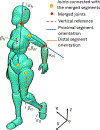A simplified model for whole-body angular momentum calculation
- PMID: 36792238
- PMCID: PMC9970829
- DOI: 10.1016/j.medengphy.2022.103944
A simplified model for whole-body angular momentum calculation
Abstract
The capability to monitor gait stability during everyday life could provide key information to guide clinical intervention to patients with lower limb disabilities. Whole body angular momentum (Lbody) is a convenient stability indicator for wearable motion capture systems. However, Lbody is costly to estimate, because it requires monitoring all major body segment using expensive sensor elements. In this study, we developed a simplified rigid body model by merging connected body segments to reduce the number of body segments, which need to be monitored. We demonstrated that the Lbody could be estimated by a seven-segment model accurately for both people with and without lower extremity amputation.
Keywords: Angular momentum; Gait stability; Rigid body model; Wearable system.
Copyright © 2022. Published by Elsevier Ltd.
Conflict of interest statement
Declaration of Competing Interest The authors declare that they have no known competing financial interests or personal relationships that could have appeared to influence the work reported in this paper.
Figures



Similar articles
-
Estimation of sagittal-plane whole-body angular momentum during perturbed and unperturbed gait using simplified body models.Hum Mov Sci. 2024 Feb;93:103179. doi: 10.1016/j.humov.2024.103179. Epub 2024 Jan 21. Hum Mov Sci. 2024. PMID: 38244350
-
Inertial sensor-based measures of gait symmetry and repeatability in people with unilateral lower limb amputation.Clin Biomech (Bristol). 2020 Feb;72:102-107. doi: 10.1016/j.clinbiomech.2019.12.007. Epub 2019 Dec 13. Clin Biomech (Bristol). 2020. PMID: 31862603
-
Mediolateral angular momentum changes in persons with amputation during perturbed walking.Gait Posture. 2015 Mar;41(3):795-800. doi: 10.1016/j.gaitpost.2015.02.008. Epub 2015 Feb 27. Gait Posture. 2015. PMID: 25797789 Free PMC article.
-
[Motion analysis in lower limb exoprosthetics-possibilities and limitations].Orthopadie (Heidelb). 2023 Aug;52(8):631-642. doi: 10.1007/s00132-023-04408-z. Epub 2023 Jul 17. Orthopadie (Heidelb). 2023. PMID: 37458809 Review. German.
-
Gait analysis in lower-limb amputation and prosthetic rehabilitation.Phys Med Rehabil Clin N Am. 2014 Feb;25(1):153-67. doi: 10.1016/j.pmr.2013.09.006. Phys Med Rehabil Clin N Am. 2014. PMID: 24287245 Review.
Cited by
-
Investigating the Association of Quantitative Gait Stability Metrics With User Perception of Gait Interruption Due to Control Faults During Human-Prosthesis Interaction.IEEE Trans Neural Syst Rehabil Eng. 2023;31:4693-4702. doi: 10.1109/TNSRE.2023.3328877. Epub 2023 Dec 4. IEEE Trans Neural Syst Rehabil Eng. 2023. PMID: 37906490 Free PMC article.
References
-
- Salzman B, Gait and balance disorders in older adults. American family physician, 2010. 82(1): p. 61–68. - PubMed
-
- Williams SB, et al., Feasibility and outcomes of a home-based exercise program on improving balance and gait stability in women with lower-limb osteoarthritis or rheumatoid arthritis: a pilot study. Archives of physical medicine and rehabilitation, 2010. 91(1): p. 106–114. - PubMed
Publication types
MeSH terms
Grants and funding
LinkOut - more resources
Full Text Sources

